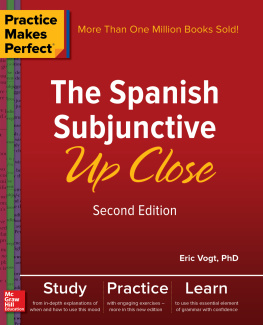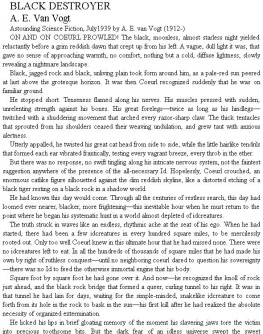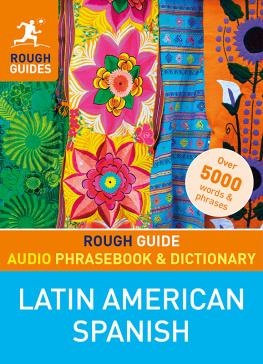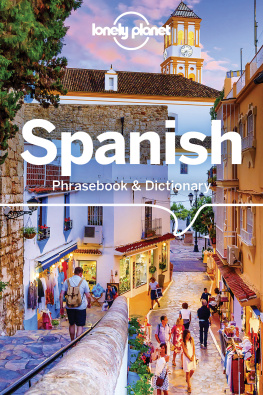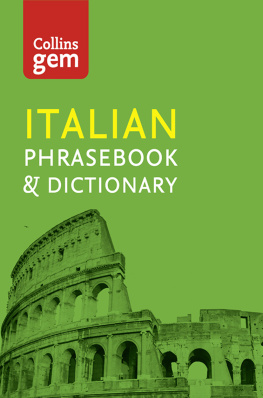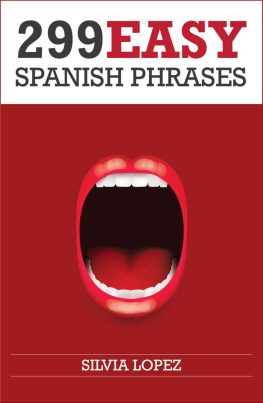PERFECT PHRASES in Spanish
for Confident Travel to Mexico
The No Faux-Pas Phrasebook
for the Perfect Trip
Eric Vogt


Copyright 2009 by The McGraw-Hill Companies, Inc. All rights reserved. Except as permitted under the United States Copyright Act of 1976, no part of this publication may be reproduced or distributed in any form or by any means, or stored in a database or retrieval system, without the prior written permission of the publisher.
ISBN: 978-0-07-160482-6
MHID: 0-07-160482-0
The material in this eBook also appears in the print version of this title: ISBN: 978-0-07-160481-9, MHID: 0-07-160481-2.
All trademarks are trademarks of their respective owners. Rather than put a trademark symbol after every occurrence of a trademarked name, we use names in an editorial fashion only, and to the benefit of the trademark owner, with no intention of infringement of the trademark. Where such designations appear in this book, they have been printed with initial caps.
McGraw-Hill eBooks are available at special quantity discounts to use as premiums and sales promotions, or for use in corporate training programs. To contact a representative please visit the Contact Us page at www.mhprofessional.com .
TERMS OF USE
This is a copyrighted work and The McGraw-Hill Companies, Inc. (McGraw-Hill) and its licensors reserve all rights in and to the work. Use of this work is subject to these terms. Except as permitted under the Copyright Act of 1976 and the right to store and retrieve one copy of the work, you may not decompile, disassemble, reverse engineer, reproduce, modify, create derivative works based upon, transmit, distribute, disseminate, sell, publish or sublicense the work or any part of it without McGraw-Hills prior consent. You may use the work for your own noncommercial and personal use; any other use of the work is strictly prohibited. Your right to use the work may be terminated if you fail to comply with these terms.
THE WORK IS PROVIDED AS IS. McGRAW-HILL AND ITS LICENSORS MAKE NO GUARANTEES OR WARRANTIES AS TO THE ACCURACY, ADEQUACY OR COMPLETENESS OF OR RESULTS TO BE OBTAINED FROM USING THE WORK, INCLUDING ANY INFORMATION THAT CAN BE ACCESSED THROUGH THE WORK VIA HYPERLINK OR OTHERWISE, AND EXPRESSLY DISCLAIM ANY WARRANTY, EXPRESS OR IMPLIED, INCLUDING BUT NOT LIMITED TO IMPLIED WARRANTIES OF MERCHANTABILITY OR FITNESS FOR A PARTICULAR PURPOSE. McGraw-Hill and its licensors do not warrant or guarantee that the functions contained in the work will meet your requirements or that its operation will be uninterrupted or error free. Neither McGraw-Hill nor its licensors shall be liable to you or anyone else for any inaccuracy, error or omission, regardless of cause, in the work or for any damages resulting therefrom. McGraw-Hill has no responsibility for the content of any information accessed through the work. Under no circumstances shall McGraw-Hill and/or its licensors be liable for any indirect, incidental, special, punitive, consequential or similar damages that result from the use of or inability to use the work, even if any of them has been advised of the possibility of such damages. This limitation of liability shall apply to any claim or cause whatsoever whether such claim or cause arises in contract, tort or otherwise.
Contents
Acknowledgments
Thanks are very much in order to my administrative assistant, Ms. Marilyn Hancock, who knows no Spanish and was so willing to read aloud the phrases using the pronunciation guide.
My most heartfelt thanks go to my dear wife, Arlene, and my sweet daughter, Alexandra, neither of whom ever doubted that I would succeed in taking on a quick succession of these projects. Words can never express the comfort and energy their confidence in me has supplied. To them and, of course, to all who travel for business or pleasure, I dedicate this little volume.
Finally, I give my hearfelt thanks to my editor at McGraw-Hill Garret Lemoi for is patience and encouragement throughout this project. Without his skillful guidance, I never would have finished this phrasebook.
Introduction
Travel to Mexico. The phrase evokes as many images as there are ears to hear it. There are many Mexicos. As a nation, Mexico is a mosaic of old and new, of native peoples, Europeans, and, of course, of the mostly mestizo population that resulted from what the Mexicans refer to not as the Discovery of America, but as the Encounter of Two Worlds with the Conquest of Mexico by Hernn Corts in 1521.
One of Mexicos great intellectuals of modern times, Octavio Paz, observed that a pyramid is a good image through which to understand Mexicos diversity. He noted that there are Mexicans who live almost untouched by the arrival of the Europeans, though they are fewer and fewer every day. There are others who live in an almost medieval European world, and then there are those who live much like anyone in a wealthy borough of New York City or San Francisco.
Mexicans tend to be very hospitable and friendly. Im sure youve heard the expression Mi casa es su casa (My house is your house). When a Mexican says this, it is not a casual statement. It is genuine. Likewise, if an American says it to a Mexican, it will be taken as a serious invitation to make himself or herself at home in your place, without necessarily announcing their arrival. Inviting someone to lunch is taken seriously, unlike the often meaningless lets do lunch one hears in the United States.
That said, Mexicans tend to observe formalities in forms of address and are sensitive about etiquette and good manners. The best way to grasp this is to remember that being on a first-name basis with Mexicans is not something that happens as quickly as it does in the United States. When it comes to initiating a change in the level of formality, it is best to allow them to take the lead, because they will initiate the change according to the rules of their culture.
Racially and socioeconomically, Mexico is quite diverse. In terms of her geography and climate, she can be divided roughly into three east-west bands from north to south. In the north, she shares the desert climate of the four U.S. states that border her six. This is her industrial region, though agriculture is also a major source of revenue. In the middle she is semi-arid, more seasonal, and densely populated. This is where Mexico City is located. It is where most of her great universities and hubs of political power are located. Lastly, the south is tropical, economically poor, and culturally rich. The south of Mexico is where the bulk of her pure native populations is found and where many people do not speak Spanish. This is where one may visit the Mayan ruins and the jungles of Yucatn. On the coasts of Yucatn one finds Cancn, Cozumel, and other favorite tourist destinations, famous for their five-star hotels, beaches, food, reef diving, and so forth. Mexicos west coast is probably best known by Americans because it is so accessible from California and Arizona, whether by car, bus, train, plane, or boat. The west coast includes Baja California (divided politically into Norte and Sur), La Paz, Puerto Peasco (with its English name, Rocky Point), Guaymas, Mazatln, Puerto Vallarta, Ixtapa, and Acapulco, to mention the major cities where many people from north of the border go for sun, relaxation, and deep-sea fishing.





